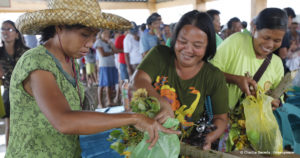With less than 90 days to move from idea to launch, Breakthrough’s Board the Bus campaign was planned swiftly and dynamically by a growing team of staff, partners and volunteers. Given the time frame, Breakthrough made what indeed turned out to be a wise strategic decision to focus on immediate results and impact rather than risk getting bogged down in needlessly cumbersome planning processes.
We recently hopped on Skype to talk with Breakthrough staff in Delhi about Board the Bus.
A Call to Action for Everyone
Breakthrough is a global human rights organization dedicated to preventing violence against women and girls by changing the cultural norms that enable violence. From offices in New York City and India, Breakthrough works to change culture using cultural activities, including multimedia, social network campaigns, and leadership training all supported with community engagement and organizing.
Few stories of violence against women in India are as well known globally as the December, 2012, rape and murder of 23-year old Nirbhaya on a south Delhi bus. Something as simple (and essential) as getting around the city is a high-risk ordeal for women, altering both the physical and psychological well-being of all city residents.
At an all-staff meeting in late-2013, Breakthrough staff got together in small groups and brainstormed campaign ideas. The basic idea of Board the Bus was sketched out in 30 minutes. The core idea: “regaining public space” for women. The idea was conceived as an action that would happen along one Delhi bus corridor over a week. Participants would be asked to:
1. Board a designated public bus.
2. Take a selfie.
3. Post the photo to social networks where friends, family and people like them would see and share the action.
The aspirational action (seeing people take back buses and feeling secure in taking a bus themselves) would grow over the week. Social media wasn’t seen just as a way to let people know about the campaign (though it served that purpose) but as a core way of engaging in the campaign. Along the way, posting and commenting on photos would solidify alignment with the campaign and extend messaging beyond the day of action.
Small and Flexible Team Opens Up the Campaign
Organizers chose to have the campaign coincide with International Women’s Day (Saturday, March 8, 2014). It was a natural hook for Board the Bus and Indian newspapers were already interested in covering International Women’s Day. Timing the campaign alongside a media event helped extend its reach. Board the Bus became an International Women’s Day event that the press could write about in the days leading up to March 8th.
The small Delhi-based team at Breakthrough has developed a resilient network of staff, partners, and volunteers as well as a network of others working to prevent harassment and violence against women. These partners helped create and implement campaign activities that further extended its reach. A contact at the Vodaphone Foundation, for example, came up with and helped create an online game as well as an interactive voice response system (IVRS) to help engage and inform mobile phone users. The IVRS gave information about the event and also gathered and shared personal stories. The system was used by over 2,100 people during the campaign.
Rolling with the Changes
Careful, detailed far-in-advance planning of course has its upsides. However, unencumbered by long-held, rigid plans and expectations, the Board the Bus team found themselves able to nimbly roll and pivot with unexpected developments.
The first big shift came when the team realized that managing and measuring bus actions across a week was too much to do well. The team was comfortable tracking social media and other online data (see image to right) was possible but didn’t feel it had the capacity to properly sustain a week-long action.
Staff chose to have the event occur on just one day, International Women’s Day on Saturday, March 8. They would use the week leading up to it to spread the word.
A second surprise came when representatives of one of the city’s main bus systems, Delhi Integrated Multi-Modal Transit Systems (DIMTS), read about Board the Bus in the Times of India the week of March 8 and asked if they could support the project by providing buses to it.
Partnering with DIMTS gave Board the Bus planning flexibility. They were no longer taking over a bus—they could count on a bus being where it was supposed to be at a set time and a supportive driver. DIMTS also gave the Board the Bus action access to Connaught Place, a highly visible central square in Delhi that gave Board the Bus unexpected exposure.

Board the Bus social media use data put together by Breakthrough. Bell Bajao is a second Twitter account run by Breakthrough.
Board the Bus Rolls through Delhi
On Saturday, March 8, 2014, over 300 people boarded buses and circled Delhi’s crowded Connaught Square in buses covered with banners. Speakers and dancers worked the crowd to engage onlookers before and during the event, extending social media coverage. University students participated in related events across the city. Organizers were concerned about nearby political rallies taking attention from the event but they didn’t impact Board the Bus.
Board the Bus Reach
Just 300 people directly participated in the Board the Bus action on March 8th by actually getting on the bus. But the campaign reached far more people due to good use of social media, mobile, video, press and other communications. The following numbers help describe campaign reach:
- 91,000 Twitter users
- Over 3,000,000 Facebook users
- 7,800 visitors to the Board the Bus website
- 2,100 calls to the Interactive Voice Response System
- Over 100,000 people followed or interacted with Board the Bus via mobile
- 2,800 video views
- 2,120 people participated on ground in Delhi
The impact of Board the Bus can’t be measured by the number of people that hopped on buses on March 8. The campaign was crafted to take advantage of social networks and used photos, video, games, mobile, IVRS, press outreach and on the ground events to give thousands of people a way to participate in the campaign with their own message regardless of where they were on March 8.
The Breakthrough team wonders if, with more planning time and resources, they would have been able to turn out 600 people instead of 300. It seems, however, that the power of Board the Bus (like many network-centric actions) can’t be defined by direct participants.
Takeaways
- Organize for individual empowerment and collective power. The action of “Boarding the Bus” tightly wound a theory of change (individuals can stop harassment by reclaiming public space as a group) with something any person (male or female) could do (and share online).
- Take advantage of every communications channel and event. Board the Bus organizers knew their time and resources were limited so they used every channel they could to spread the word and engage people to help share the message.
- Don’t let detailed, long-term planning become the goal. It would have been easy for Breakthrough to decide there wasn’t enough time to “do it right” and wait a few more months or not do it at all. Waiting would have taken away the International Women’s Day hook, however. Breakthrough trusted the power of their message and the ability of partners and volunteers. They focused on taking advantage of networks to spread the word and create impact. Instead of planning, they did the work and adjusted as they went.




